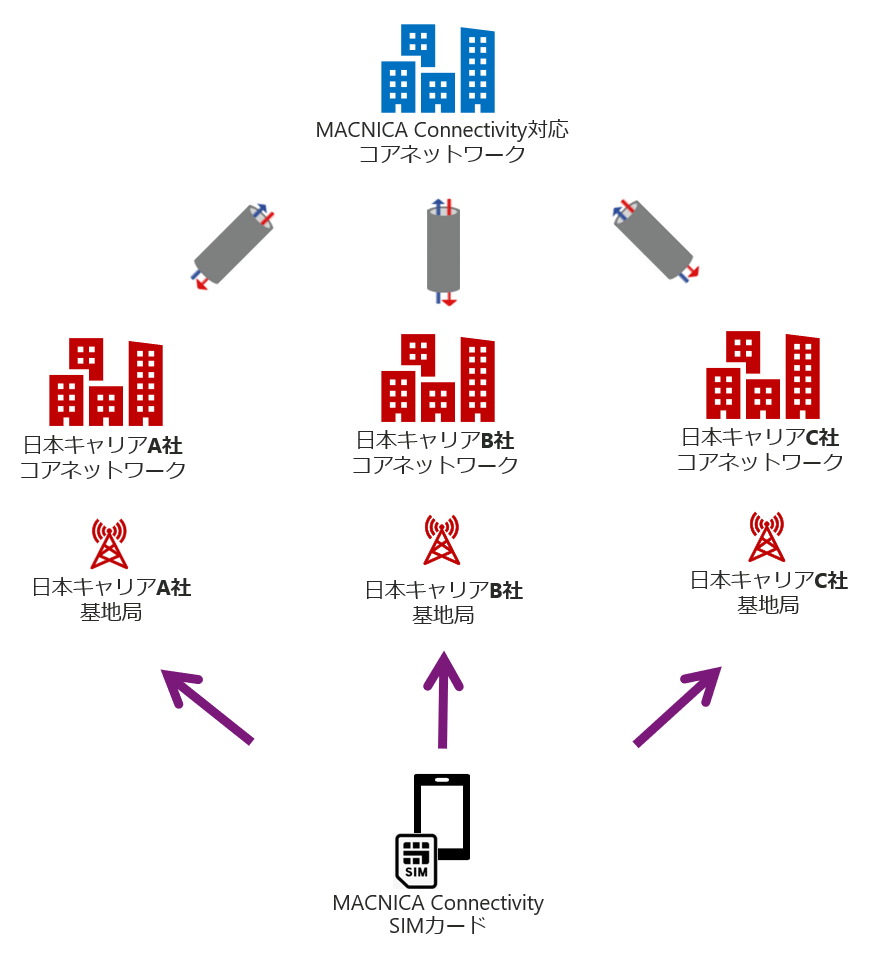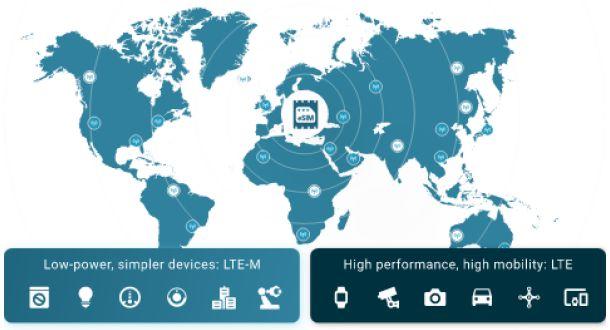
What is a multi-carrier compatible SIM?
Recently, the number of opportunities to see the keyword "multi-carrier support" has increased. Literally, this means that it supports multiple (multiple) mobile phone lines (carriers) that can be connected with a single SIM card.
Macnica Connect SIM is also compatible with multiple carriers, and we will start by explaining the basics of roaming and then go into more detail.
Roaming overview
When communicating outside the service area provided by the carrier you are contracted with, roaming is a method of wireless communication using the base station or radio waves of another carrier with which the carrier is affiliated. Since this service does not require the user to prepare a new SIM card, it is widely used as a wireless communication service when traveling overseas.
The roaming mechanism is introduced in the reference URL article "Roaming and Full MVNO", so please refer to that as well.
How multi-carrier SIM connections work
Characteristics of use in Japan

The biggest feature of Macnica Connect SIM when used in Japan is that it is multi-carrier compatible, meaning that it provides roaming services using the major carrier lines in Japan.
Access to our core network is realized via the carrier line that can be connected at that time according to the specification environment, communication time zone, and device settings.
As a result, there is basically no need to be aware of the carrier on the device side, but on the other hand, we have recently received inquiries about carrier designation. In the "Mechanism for multi-carrier support" described later, we will explain the case of specifying a carrier and the mechanism of automatically selecting a connection carrier.
Features of overseas use

The biggest feature of Macnica Connect SIM is its high coverage, providing roaming services in over 190 countries around the world.
In the same way as the connection method referred to above in "Characteristics of Use in Japan", access to our core network is achieved via carrier lines with roaming partners in each country.
For example, in the case of the EU, as in the case of ``using carrier line services on mobile terminals between land-connected countries,'' communication services can be provided without being conscious of carrier discrepancies that occur when crossing countries. It is possible to continue.
Mechanism for multi-carrier support
About connected carriers and profiles

When designing a device using a carrier line, there are cases where we receive inquiries from customers regarding carrier designation for the time being.
Here is a brief explanation of how to select and decide which carrier to connect to. After starting the wireless device, (1) the device recognizes the broadcast information sent by each carrier. ② Among them, select the notification information based on the SIM card being inserted and the carrier profile set on the device side. Here, the carrier profile is a setting file determined for each carrier. For example, in the case of iPhones that are deployed globally, the carrier profile of the country of deployment is saved in advance.
In other words, the SIM card itself does not have a function to select the carrier to connect to, and it is necessary to manage and set it on the device side.
Macnica Connect SIM basically guides you to "Automatic Acquisition (Global, Generic Profile, etc.)" and recommends you to select more notification information and decide the connection carrier. On the other hand, if you need to specify the connection carrier, please manage and set it on the device you are using.
Macnica Connect SIM Multi-carrier connection mechanism

In multi-carrier networks, a multi-carrier connection is achieved using a mechanism called Fallback.
Two types of IMSI are supported: Primary IMSI and Fallback IMSI. The optimal IMSI will be selected based on the installation environment, and the connection carrier will be determined.
①: After starting the device, scan the surrounding MCC (Mobile Country Code) information.
(2): After detecting the corresponding MCC, attempt to connect to carrier A supported by Primary IMSI. Here, Primary IMSI enables two types of carrier connection, and when carrier A connection fails, it tries to connect to another carrier B.
③: When connection to any carrier that supports Primary IMSI fails, the SIM card automatically switches to IMSI and acts as Fallback IMSI.
④: Fallback IMSI also tries to connect to the corresponding carrier C.
⑤⑥:After connecting to Fallback IMSI, the counter owned by the SIM card will start. This determines the Expire time to switch back to Primary IMSI and attempt to reconnect.
According to the above flow, the optimal connection carrier is determined by automatically switching IMSI according to the environment.
Summary
This page introduces the mechanism of multi-carrier compatibility, which is a feature of Macnica Connect SIM. By using this SIM card, users do not need to be aware of the carrier they are connecting to or its coverage, and stable communication services are provided.
Please refer to the links below for explanations of various glossaries.
